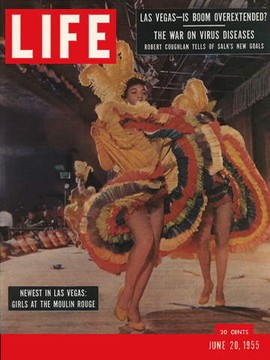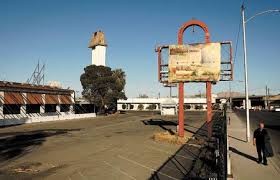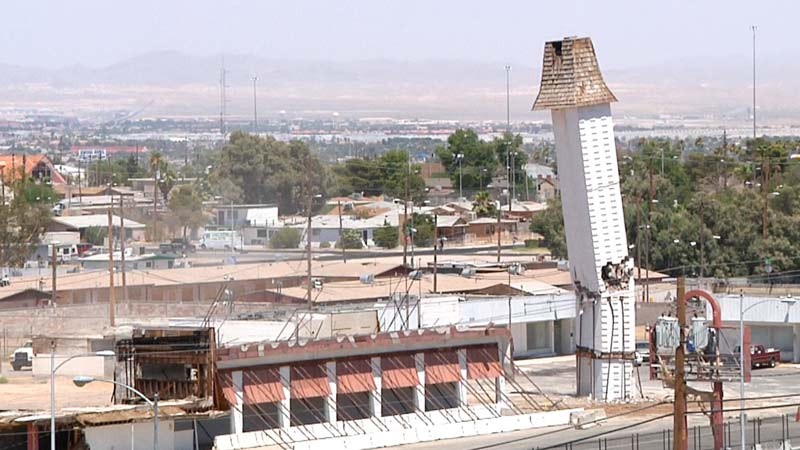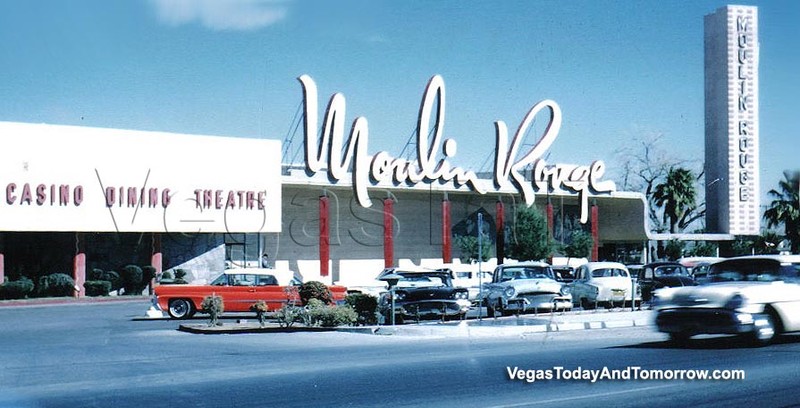Moulin Rouge Hotel (1955)
Introduction
Text-to-speech Audio
Listed in 1992 on the National Register of Historic Places, Moulin Rouge Hotel was a symbol of the Black civil rights movement and a reminder of Las Vegas's racist past. The Moulin Rouge Hotel open its doors on May 24, 1955 and became the first Las Vegas hotel and casino to cater to all races. Although preservationists and supporters of African American history hoped to save the historic property, most of the original hotel was demolished.
Images
Magazine detailing the importance of the Moulin Rouge to the Civil Rights Movement and the entertainment industry.

The Moulin Rogue before demolition - various casinos and hotels around the strip have parts of this once grand hotel.

When the city decided to demolish the "unsafe" pillar that stood for so long, against protests from many historians, it took them nearly an entire day to just destabilize it for demolition.

A recreation of what the grand hotel once looked like in its prime.

Backstory and Context
Text-to-speech Audio
Though its lifespan was short, the Moulin Rouge hotel occupies a significant space in the history of Las Vegas. At a time when Las Vegas was segregated, most of downtown--including restaurants, hotels, and entertainment venues--was off-limits to African Americans. Consequently, the city's Westside neighborhood, which had long been home to African American families, offered a place for people of color to eat and shop with dignity. The neighborhood was also home to with numerous jazz clubs and nightspots.
The Moulin Rouge, which was named for the famed Parisian nightclub, opened in May of 1955. The hotel was the brainchild of developer Will Max Schwartz with the support of investors Alexander Bisno and Louis Rubin, as well as boxer Joe Louis. Located just on the edge of the Westside, the club was intended to bridge the divide between white and Black Las Vegas. Not only was it the first desegregated casino in the city, it was the first casino in the United States built to serve all races.
In its first week, the Moulin Rouge hosted the Platters as entertainment. Other early guests of the hotel include Tallulah Bankhead, Edward G. Robinson, and Harry Belafonte. Moulin Rouge played host to great white and Black singers and performers alike, including many A-list entertainers such as Sammy Davis Jr., Nat King Cole, Judy Garland, Sophie Tucker and Frank Sinatra. Within a few weeks, the venue was popular enough that a third show beginning at 2:30AM was added.
The hotel cost an estimated $3.5 million and featured 110 rooms, 7 suites, a full size swimming pool, and the casino, showroom and bar. The hotel and casino also included stylistic features designed to mirror the glitz of Paris. The sign featured the Eiffel Tower, a design that was also featured on the casino's chips. For dining, patrons had a French chef at their disposal.
Not only was the Moulin Rouge popular, it inadvertently became a force for change in the city. Many of the club's patrons became civil rights activists and the club itself--a model of biracial cooperation--is seen by many as the spark that helped to end segregation in Las Vegas. However, casino closed suddenly after four-and-a-half months. When employees came to work one day in October of 1955, they found the Moulin Rouge padlocked. No one seems to know exactly what happened to the club. Some speculate that mobsters or rival nightclub owners had it shut it down to eliminate competition. Some blame the proliferation of downtown establishments in better locations, or the inability of the largely African American Westside to support the venue.
For a number of years, the building that once housed the Moulin Rouge was home to other businesses such as a motel, a public housing apartment complex, and a flophouse. Preservationists and historians made numerous efforts to save the property, but plans staled and a fire on May 29, 2003 that severely damaged the complex reduced the likelihood of the building's preservation. The following January, the Moulin Rouge sold for $12.1 million, and a $200 million renovation was announced. In May 2009, however, the building caught fire again, causing significant damage to the original hotel lobby.
Though the building had been listed on the National Register of Historic Places in 1992, the remains of the structure were demolished by the city because of safety concerns in 2010. Because of a quirk of Nevada gaming laws, which require that gambling take place occasionally to maintain a gaming license, gambling still takes place at the site every two years. Video poker machines are brought in for the day in order to keep the Moulin Rouge's gaming license, even though the casino closed in 1955.
The Moulin Rouge, which was named for the famed Parisian nightclub, opened in May of 1955. The hotel was the brainchild of developer Will Max Schwartz with the support of investors Alexander Bisno and Louis Rubin, as well as boxer Joe Louis. Located just on the edge of the Westside, the club was intended to bridge the divide between white and Black Las Vegas. Not only was it the first desegregated casino in the city, it was the first casino in the United States built to serve all races.
In its first week, the Moulin Rouge hosted the Platters as entertainment. Other early guests of the hotel include Tallulah Bankhead, Edward G. Robinson, and Harry Belafonte. Moulin Rouge played host to great white and Black singers and performers alike, including many A-list entertainers such as Sammy Davis Jr., Nat King Cole, Judy Garland, Sophie Tucker and Frank Sinatra. Within a few weeks, the venue was popular enough that a third show beginning at 2:30AM was added.
The hotel cost an estimated $3.5 million and featured 110 rooms, 7 suites, a full size swimming pool, and the casino, showroom and bar. The hotel and casino also included stylistic features designed to mirror the glitz of Paris. The sign featured the Eiffel Tower, a design that was also featured on the casino's chips. For dining, patrons had a French chef at their disposal.
Not only was the Moulin Rouge popular, it inadvertently became a force for change in the city. Many of the club's patrons became civil rights activists and the club itself--a model of biracial cooperation--is seen by many as the spark that helped to end segregation in Las Vegas. However, casino closed suddenly after four-and-a-half months. When employees came to work one day in October of 1955, they found the Moulin Rouge padlocked. No one seems to know exactly what happened to the club. Some speculate that mobsters or rival nightclub owners had it shut it down to eliminate competition. Some blame the proliferation of downtown establishments in better locations, or the inability of the largely African American Westside to support the venue.
For a number of years, the building that once housed the Moulin Rouge was home to other businesses such as a motel, a public housing apartment complex, and a flophouse. Preservationists and historians made numerous efforts to save the property, but plans staled and a fire on May 29, 2003 that severely damaged the complex reduced the likelihood of the building's preservation. The following January, the Moulin Rouge sold for $12.1 million, and a $200 million renovation was announced. In May 2009, however, the building caught fire again, causing significant damage to the original hotel lobby.
Though the building had been listed on the National Register of Historic Places in 1992, the remains of the structure were demolished by the city because of safety concerns in 2010. Because of a quirk of Nevada gaming laws, which require that gambling take place occasionally to maintain a gaming license, gambling still takes place at the site every two years. Video poker machines are brought in for the day in order to keep the Moulin Rouge's gaming license, even though the casino closed in 1955.
Sources
Cook, Kevin. The Vegas Hotspot that Broke all the Rules. Smithsonian.com. January 01, 2013. Accessed January 20, 2018. https://www.smithsonianmag.com/history/the-vegas-hotspot-that-broke-all-the-rules-165807434/.
